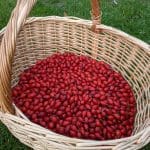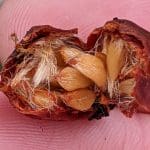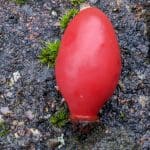How to harvest and process wild roses
The country side of the UK is abundant wild roses, 13 native and 9 introduced according to BSBI, many of them hybridising and with very similar appearance. Two of the most common are:
Dog rose Rosa Canina add link to id guide
Japanese rose Rosa Rugosa add link to id guide
If you haven’t already check out our ID guides linked above
They have been used for centuries for their beauty, wonderful flavours and array of fantastic medicinal properties.
The great thing about wild roses is they are all edible and can be used for recipes interchangeably, so as long as you are 100% certain you have a wild rose species- first part of the botanical name beginning with “Rosa” it doesn’t matter which one edibility wise. You can even use garden varieties. The harvesting, prep and recipes you can make with them are all the same.
Harvest Time and Techniques
Flowers- from late spring to early summer so about May- June. The petals are the only part needed so if you carefully pull just the petals the rest of the flower will remain to go on to produce a rose hip. They will keep well for a few days in a cool place for long term storage they also dry well.
Rose hips- Autumn, the season is quite long for rose hips, they can be seen even in late summer and last on the shrubs well into January, but simply once the hips turn red they are ripe and ready to use. The traditional time to collect rose hips is just after the first frost as the freezing breaks the cells within making them softer and sweeter. This is called bletting, but we now have the modern technology of freezers so can start earlier if we wish.
When collecting your rose hips it will be useful to take a pair of gloves to protect from the thorns also some secateurs as it’s only when they are really soft do they come away from the stem easily.
Edible parts and uses
Leaves
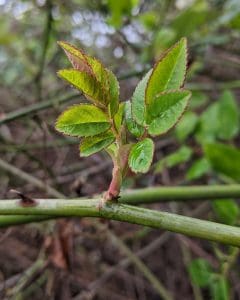
When very young in spring they can be added to salads and stir fries. Different species have varying levels of spines and thorns, so have a little check first but generally they are very smooth at this age, like pictured above. Dog rose Rosa Canina is my favourite for this.
Rose petals
Floral and perfumed with a light sweetness


Decoration
Can be used for their beauty and light sweetness for decoration on desserts and in salads or any food that they will compliment. Rose petals are well known for flavouring Turkish delight.
Infusion
Rose petals work excellent as an infusion into many different vinegars, syrups or alcohols and jellies so have an experiment! The flavours are water soluble so take little time to infuse. They will tint your recipe similar of the petals them selves, if you want a striking pink you can use Japanese rose Rosa rugosa or other strongly coloured roses from your garden.
This is a two part goodie! Because with these recipes you get two products-
- A Rose infused condiment, alcohol or syrup.
- Petals that have been pickled, or syrup and alcohol soaked which are delicious.
Simple recipe for Rose flower vinegar
Melt together with heat on the hop 400ml of your choice of vinegar and 2 heaped tablespoons of brown sugar ( or an amount to your taste) Once cooled, pour into a clean jar that has been stuffed full of rose petals. Fill almost to the top, as vinegar can degrade most jar lids. Leave for 5 days then decant the vinegar into a suitable bottle and keep the rose petals in a jar in the fridge ready to use on dessert, salads or especially with Turkish and moroccan like dishes.
Jams and desserts
The petals work great in jam or sweet pickles also for sorbet, ice cream and jelly. Another way to use them is to incorporate them in no-bake slices like tiffin.
Tea
Petals can be dried and made into blends of loose leaf tea.
Rose hips
A unique flavour of a sweet tangy tomato/strawberry.

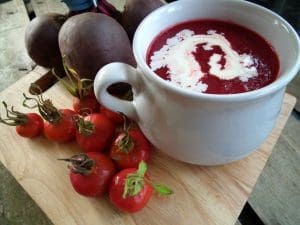
There’s a little way you can get a taste of Rose hips before collecting 100’s of them. Once they are soft ( pull off the shrub easily) there will be a little hole where it was just attached to the stem. Give the hip a very gentle and even squeeze so the pulp oozes out like toothpaste from the hole, and try! if the seeds also push out you’ve pushed too hard and if lots of juice comes out its fermenting, in both cases toss it and get another.

Rose hip syrup
This is honestly just lovely, It is simply Rose hip pulp and sugar. There are a few ways you can make this depending on if you want to do less work and how quickly you want result. For all methods it’s best to have your rose hips already soft either by collecting after the frost or having stuck them in and out the freezing a couple of times.
The reason to have them soft first is so they are sweeter, need minimal processing which preserves more vitamin C and to get the more of the delicious pulp.
For method one 1 and 2 first you need the pulp…..
Place your whole washed soft rose hips into a pan. If a few have bits of stalk on it’s no problem. Add enough water to cover and simmer on a medium heat until they are soft enough to mash into a pulp.
Now you sieve the pulp, theres two different ways depending if you want a thicker puree or a flavoured liquid/jelly- but the most important thing is you use a cheesecloth or jelly bag, it has to be a tightly woven mesh to stop the irritating little hairs inside coming through so a regular metal sieve or will not do.
Method 1- Best for puree, pickle, sauces, jam, thicker syrup.
Roll up your sleeves and with your cheesecloth squeeze the pulp through the mesh, it takes a little work but worth it for the rich thick result.
I usually do a double squeeze. Once I can’t get any more puree through, I put it back in the pan and add more water and squeeze through again or go to method 2. It’s amazing how much more you get, the second lot is thinner but still great for syrups!
Method 2- Best for cordial, drinks, jellies and a thinner syrup.
You may want to water down your pulp a little more first then leave it hanging in a jelly bag overnight this will result in a translucent flavoured liquid.
Now you just need to add sugar, Demerara is considered the tastiest by most people but any is fine. You can add an amount of sugar to your personal taste but if it’s under 50- 60% sugar it will have a shorter shelf life as it wont naturally preserve, you will need to refrigerate, freeze or use jam/pickling heat methods for longer storage.
Method 3
With your cleaned and dried soft rose hips, get a clean jar and layer 50-50 of rose hips and sugar ( demerara is best) in a lasagna like way, then pop the lid on and leave in a temperate place out of the sun, in 1-3 months a syrup will have formed all by itself. Because sugar is hydrophilic ( loves moisture) it draws the juices from the rose hips out and forms a syrup. It’s ready once all the sugar has liquified, though I often leave it an extra couple of weeks after to make sure all the flavour is infused. Before serving if any of the rose hips are broken you will need to sieve the syrup through a cheesecloth or jelly bag to make sure the seeds and hairs are left behind.
Extra tips…
If you’re worried some hairs have made it through into your syrup, leave it standing overnight and they mostly float to the top so you can just scoop them out.
It is possible to put them through a low power food processor briefly before heating to help break them up. I’ve done this and still successfully sieved the hairs and seeds out. But it must be a light chop up not liquefying something like a Nutribullet is way too powerful.
Medicinal Uses and nutrition
Rose petals
Drinking Rose petal tea is an important part of Traditional Chinese medicine.
It’s a good source of vitamin A,C and E, also iron and calcium while containing zero fat, sugar, calories or protein.
The petals have mood stabilising and lifting properties. The smell of roses also promotes a calming and stress relieving effect.
The vitamins and antioxidants in Rose petals support skin health giving them them the strong association with beauty, many skin care products contain rose.
Rose hips
Most well known and praised for their incredible anti inflammatory properties and high Vitamin C content which is 8-20 times that of oranges with 426mg in 100g of rose hips.
Rose hips are also high in folate and contains vitamins A, B3, D and E along with flavonoids, carotenoids, betasitosterol, fructose, malic acid, tannins, magnesium, zinc, copper and numerous other phytochemicals.
Heart health
Consuming rose hips may boost heart health by lowering cholesterol and blood pressure. In a 6-week study in 31 people, drinking a rosehip beverage containing 40 grams of rosehip powder daily led to significant reductions in blood pressure, total cholesterol, and LDL (bad) cholesterol, compared with the control group.
Benefits for arthritis
Rose hips have been well studied for their effects on osteoarthritis pain. A recent review of 24 studies found that supplementing with rose hips may help relieve osteoarthritis symptoms by combating oxidative stress and inflammation in your joints. Additionally, a review of three studies noted that people taking rosehip powder were twice as likely to report improvements in osteoarthritis pain. Finally, a recent review observed that rose hips reduced pain and stiffness in those with osteoarthritis.
Skin
Rose hip oil is now a popular anti-aging substance in the beauty industry, it’s made by cold pressing rose hips and extracting their natural oils. The seeds are high in polyunsaturated fats, which supports healthy skin and protects it from damaging compounds, such as ultraviolet (UV) rays, cigarette smoke, and pollution.
In one small, 8-week study, taking 3 mg of Rose hip powder daily led to a significant decrease in skin wrinkles and significant increase in skin moisture content and elasticity.
Researchers attributed these results to rose hips’ robust antioxidant, vitamin C, and fatty acid profile, which all protect and replenish your skin barrier.
Rose hip oil may also aid wound healing. In a recent study, rats treated with this oil had significantly faster wound healing and less scar development than the control group.



